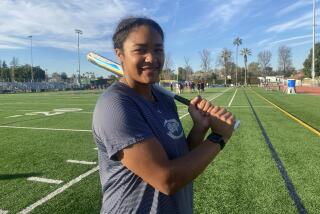SOFTBALL / PAIGE A. LEECH : New Ball Created Stir but Not More Offense
- Share via
More offense, more interest. That was the result the NCAA hoped to achieve this year by changing the look and composition of the ball in the previously pitcher-dominated sport of collegiate softball.
All three divisions of the NCAA abandoned the white leather ball with the white laces in favor of one of fluorescent yellow and red laces. Additionally, the inner core was hardened to make for a livelier ball. The NCAA hoped the changes would generate more offense--and, thus, increased spectator interest.
Although NCAA officials point to increased attendance at the Women’s College World Series as evidence of greater spectator interest, Division I teams actually scored fewer runs in 1993 than the previous year.
“The Women’s College World Series attendance erupted this year--part of it was due to (UCLA’s) Lisa Fernandez and part of it was the new ball,” said Marie Tuite, director of softball for the NCAA.
Even the media--which generally all but ignored the sport in the past--came out to see the bright yellow ball. Nationwide publications from USA Today to Sports Illustrated spread the word about softball’s newest look.
Attendance records were shattered at the Women’s College World Series. Total attendance at the Women’s College World Series in Oklahoma City vaulted from 13,490 in 1992 to 21,963 last spring. Series records also were set this past season for single-session attendance (5,017) and average-per-session (3,138).
“The overwhelming majority are excited about the new ball,” Tuite concluded.
Still, NCAA officials were surprised by the regular-season batting and pitching statistics among Division I schools. Officials assumed batting averages and earned-run-averages would increase dramatically. They did not.
Rayla Allison, executive director of the National Softball Coaches Assn., compared 1992 statistics before postseason play to those in 1993. With the softer white ball, there were 9.12 runs per game in 1992. With the harder, fluorescent yellow ball, 6.88 runs per game, a surprising decrease of more than two runs per game.
The top Division I hitter in 1992 batted .508, in 1993, .507. The best pitcher in 1992 sported an ERA of 0.07, a year later, 0.17.
“In terms of creating more offense, I don’t think it did that,” Allison said. “But, what (the new ball) did do was create more interest in the game. We just didn’t do it with offense.”
Officials believe the threat of the long ball no longer allowed coaches to sit on 2-0 and 3-0 leads in the late innings and therefore made for a more exciting game.
The regular-season home run leader in 1992 hit eight home runs. In 1993, the leader hit more than twice that, 19.
No team in the nation--at any collegiate level--hit more home runs last season than Cal State Northridge, which hit 40. Northridge shattered the previous mark of 29, set by Texas A&M; in 1985.
*
Blazing through Japan: The Foothill Blazers, an 18-and-under team that represented the American Fastpitch Assn. and the United States in the Friendship Tour/Japan in July, outscored Japanese opponents, 27-8.
The Blazers’ 12-day, 10-game tour included visits to five cities. After the team’s 3-0-1 start, the travel caught up with the Crescenta Valley-based team. Because three players became ill, the roster was reduced to nine, and the Blazers subsequently lost two consecutive games--the only losses of the tour.
The Blazers finished the tour 5-2-3 (Japanese tour rules do not allow games to extend into extra innings). But the wins and losses seemed less significant than the sights and experiences afforded the Blazers by their Japanese hosts, according to Blazer manager Tom Zimmerman.
In addition to the endless hours of sightseeing and shopping sprees, the team rode bullet trains, shook hands with mayors and chairmen of the boards of prominent businesses and went freshwater fishing in the mountains.
More to Read
Go beyond the scoreboard
Get the latest on L.A.'s teams in the daily Sports Report newsletter.
You may occasionally receive promotional content from the Los Angeles Times.










